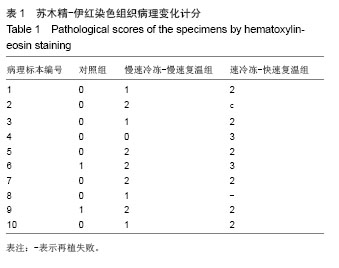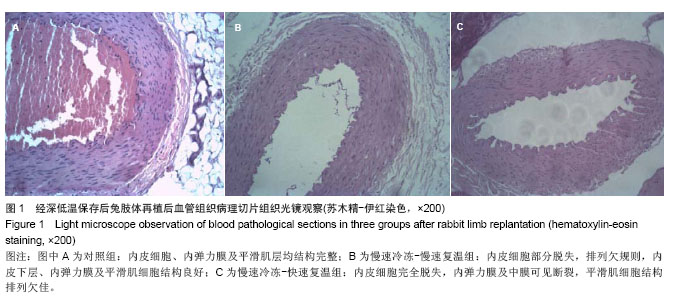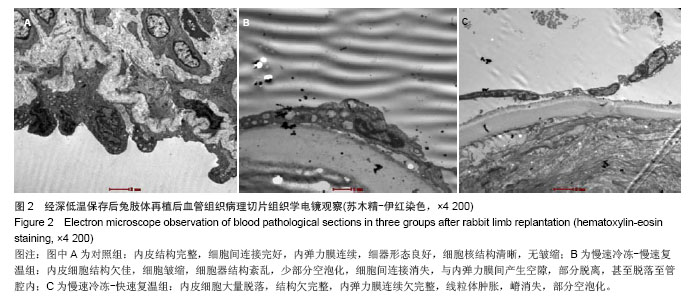| [1]De Santis L,Cino I,Rabellotti E,et al. Oocyte cryopreservation:elinical outcome of slow-cooling protocols differing in sucrose concentration.Reprod Biomed Online. 2007; 14(1):57-63.
[2]Mowlavi A, Neumeister MW, Wilhelmi BJ, et al. Local hypothermiaduring early reperfusion protects skeletal muscle from ischemia reper-fusion injury. Plast Reconstr Surg. 2003; 111(1):242-250.
[3]Buchanan S, Gross SA, Acker JP, et al. Cryopreservation of stem cells using trehalose: evaluation of the method using a human hematopoietic cell line. Stem Cells Dev. 2004;13(3): 295-305.
[4]梁琳琳,刘玉青,李杭生, 等. 玻璃化冷冻胚胎出生小鼠卵巢发育情况及卵巢组织中生长分化因子9的表达[J]. 中华妇产科杂志, 2012,47(9):676-680
[5]李正民,宫璀璀. 人脐带间充质干细胞不同冻存方法探讨[J]. 国际检验医学杂志,2012,33(12):1414-1416.
[6]范学敏,李鹏翠,丁娟,等. 玻璃化冻存对兔关节软骨细胞存活率及代谢活性的影响[J]. 中国骨与关节损伤杂志,2013,28(4): 336-338.
[7]尹叶锋,王江宁,高磊,等. 不同温度对体外模拟体内生理环境寄养断肢系统的影响研究[J].中国修复重建外科杂志,2013,27(1): 72-76.
[8]马亚红,钟力生,胡慧玉. 电场对低温保存生物组织介电特性影响的研究[J].绝缘材料,2012,46(5):49-52.
[9]王江宁,尹叶锋,高磊,等.不同氧体积分数气体对体外模拟体内生理环境寄养断肢系统血氧分压的影响[J].中国组织工程研究, 2012,16(5):855-858.
[10]The Ministry of Science and Technology of the People’s Republic of China. Guidance Suggestions for the Care and Use of Laboratory Animals.2006-09-30.
[11]夏穗生. 临床移植医学[M]. 杭州:浙江科学技术出社,1999:95.
[12]Axelsson S, Faresjö M, Hedman M, et al. Cryopreserved peripheral blood mononuclear cells are suitable for the assessment of immunological markers in type 1 diabetic children. Cryobiology. 2008;57(3):201-208.
[13]Mazur P. Freezing of living cells: mechanisms and implications. Am J Physiol. 1984;247(3 Pt 1):C125-142.
[14]Fuller B,Paynter S.Fundamentals of cryobiolog in reproductive medicine. Reprod Biomed Online. 2004;9(6): 680-691.
[15]Hermandez M,Ekwall E,Roca J,et al.Cryo-scanning electron microscopy(Cryo-SEM) of semen frozen in medium-straws from good and sub-standard freezer Al-boars. Cryobiology. 2007;54(1):63-70.
[16]Brien FJ, Harley, Yannas IV, et al. Influence of freezing rate on pore structure in freeze dried collagen-GAG scaffolds. Biomaterials. 2004;25(6):1077-1086.
[17]Fuller B,Paynter S.Fundamentals of cryobiology in reproductive medicine.Reprod Biomed Online.2004; 9(6): 650-691.
[18]Younis AI,Tover M,Albertini DF,et al.Cryobiology of non-human primate oocytes. Hum Reprod. 1996;11(1): 156-165.
[19]Gao DY,Chang Q,Lin C,et al.Fundamental cryobiology of human hematopoietic progeuitor cells.Usmotic charactersticsand volume distribution. Cryobiology. 1998; 36(1):40-48.
[20]贾晓明,柴家科,纪晓峰,等.速冻玻璃化储存异体皮的临床应用[J].军医进修学院学报,2001,22(1)1-14.
[21]Decherchi P, Lammari-Barreault N, Cochard P, et al. CNS axonal regeneration with peripheral nerve grafts cryopreserved by vitrification: cytological and functional aspects. Cryobiology. 1997;34(3):214-239.
[22]Song YC, Khirabadi BS, Lightfoot F,et al. Vitreous cryopreservation maintains the function of vascular grafts. Nat Biotechnol. 2000;18(3):296-299.
[23]Meltendorf C, Hincha DK, Hoffmann F. Vitrification of posterior corneal lamellae. Cryobiology. 2002;44(2):170-178.
[24]徐红艳,华泽钊,鲁亚南,等.血管低温保存降温过程对裂纹产生影响的实验研究[J].低温工程,2000,21(1):22-26.
[25]刘元新,张树明,乔林,等.快速冷冻与慢速冷冻条件下复合组织血管内皮的生物活性[J].中国组织工程研究,2012,16(20): 3659-3662.
[26]霍海涛,张树明,朱泽兴,等.不同复温方法对深低温冷冻复合组织血管活性的影响[J].中国医学工程,2012,20(5):26-27.
[27]Bellón JM, Gimeno MJ, Pascual G, et al. Arterial damage induced by cryopreservation is irreversible following organ culture. Eur J Vasc Endovasc Surg. 1999;17(2):136-143.
[28]王沛涛,刘海宁,舒志全,等.体外培养后深低温保存兔颈总动脉结构和力学性能[J].齐鲁医学杂志,2005,20(1):13.
[29]孙波,牟宇科.离断指体冰冻保存后再植成活1例[J].中国实用手外科杂志,2000,14(3):136.
[30]王增涛,王春霞,朱磊等.深低温保存81天断指再植1例[J].山东医药,2004,44(3):29.
[31]Cui X, Gao DY, Fink BF,et al. Cryopreservation of composite tissues and transplantation: preliminary studies. Cryobiology. 2007;55(3):295-304.
[32]张保,卜海富,桂斌捷,等.降温速率对程序化降温低温保存动脉的影响[J].安徽医科大学学报,2008,43(2):132-134.
[33]王利红,陈子江,高选. 人卵巢组织冷冻保存的实验研究[J]. 现代妇产科进展,2005,14(1):16-19.
[34]顾玉东,李继峰,姜继福,等.血管内皮细胞愈合机制探讨[J].中华显微外科杂志,1989,12(4):220-222.
[35]Wingenfeld C, Egli RJ, Hempfing A,etal.Cryopreservation ofost eochondralal lografts:dimethyl sulf oxide promot esan giogenesis and im munetol erance in mice. J Bone Joint Surg Am. 2002;84-A(8):1420-1429.
[36]张友乐,王澍寰,尹大庆,等.异体动脉移植临床应用的中远期随访[J].中华手外科杂志,2003,19(3):184-185.
[37]战杰,田立杰,许杨,等.深低温冷冻同种异体肌腱移植的远期疗效观察[J].实用手外科杂志,2002,16(1):47-48.
[38]何波涌,王朝晖,成明华,等.深低温冷冻同种异体骨移植修复骨缺损45例[J].中国骨与关节损伤杂志,2009,24(2):185-186.
[39]瞿玉兴,董天花,张志霖,等.超低温冷冻保存后同种异体神经移植的实验研究[J].中华手外科杂志,2002,18(1):59-62.
[40]贾晓明,柴家科,纪晓峰,等.速冻玻璃化储存异体皮的临床应用[J].军医进修学院学报,2001,22(1):14-16.
[41]段永壮.深低温冷冻大鼠肢体缺血再灌注损伤及依达拉奉干预的实验研究[D].南方医科大学,2007.
[42]莫家栋,宋建榕,李建东,等.低温灌注、深低温冷冻对同种异体肢体移植排斥反应的影响[J].福建医科大学学报,2006,40(4):373-377. |


